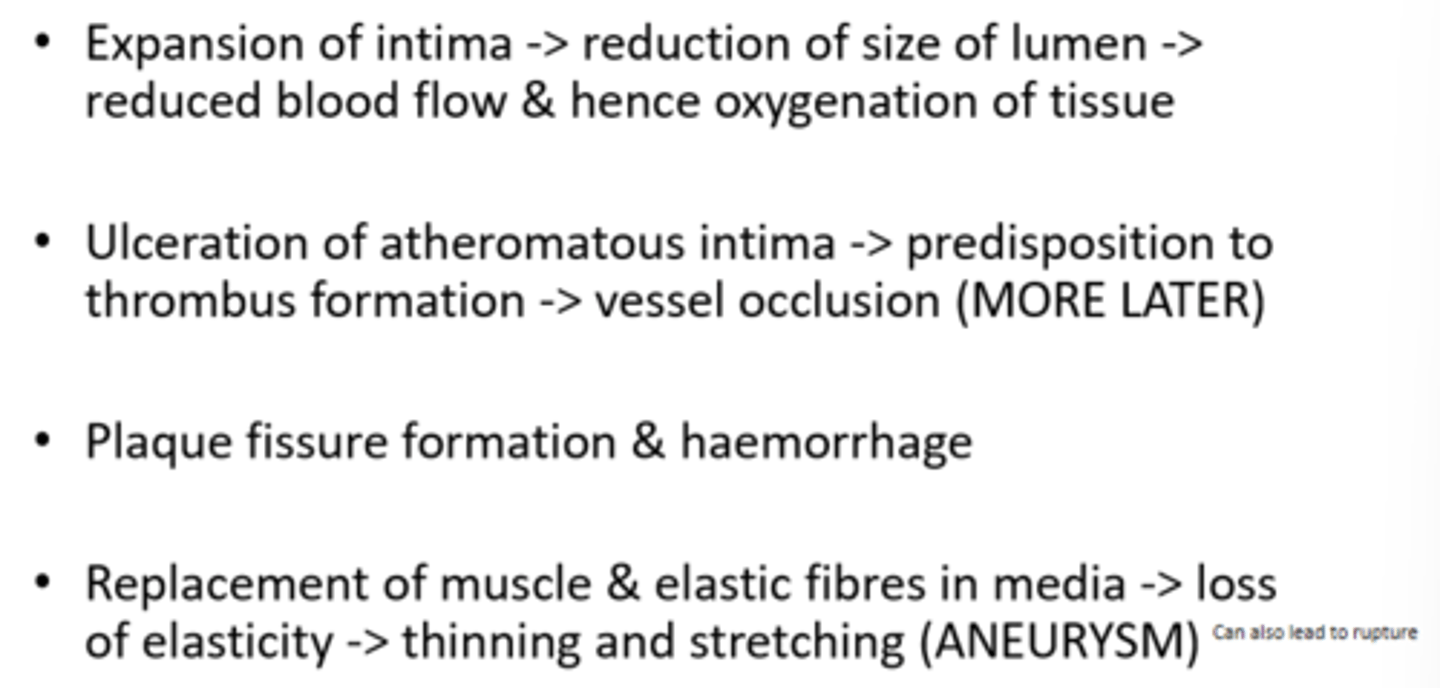Atheroma and its complications
1/25
There's no tags or description
Looks like no tags are added yet.
Name | Mastery | Learn | Test | Matching | Spaced |
|---|
No study sessions yet.
26 Terms
what is arteriosclerosis?
thickening and hardening of the wall of an artery
what is arteriolosclerosis?
thickening and hardening of the wall of an arteriole
what is atheroma?
an important disease of large and medium arteries.
what is atherosclerosis?
arteriosclerosis due to atheroma
what is the most common cause of thickening and hardening of the walls of small arteries and arterioles?
high blood pressure
what three changes would be visible on a micrograph if a vessel had hypertensive arteriosclerosis?
hypertrophy of media
fibroelastic thickening of intima
elastic lamina reduplication
what one change would occur is a vessel had arteriolosclerosis?
replacement of wall structures by amorphous hyaline material.
what are the consequences of hypertensive vascular changes?
reduction of vessel lumen > reduced flow > ischaemia in supplied tissue.
definition of atheroma?
disease of large/medium arteries.
only occurs in high pressure systems.
initially in tunica intima, later affects tunica media.
4 stages of atheroma development
1. fatty streak
2. lipid plaque
3. fibro lipid plaque
4. complicated atheroma.
atheroma development 1
blood lipids enter intima through damaged endothelium
atheroma development 2
lipids are phagocytosed by macrophages in intima to make raised fatty streak.
atheroma development 3
some lipid is released by macrophages 'lipid plaque'.
macrophages secret cytokines which stimulate myofibroblasts to secrete collagen.
early damage to elastic lamina and media.
atheroma development 4
collagen covers plaque surface 'fibro lipid plaque'.
media thins, with replacement of muscle fibres by collagen.
atheroma development 5
lipids in intima become calcified.
surface of fibro-lipid plaque ulcerates.
thinning of media leads to weakness and in elasticity 'complicated atheroma'
what are atheroma risk factors?
smoking
obesity
sedentary lifestyle
diet (high cholesterol)
complication of atheroma 1

what does the reduction of lumen lead to?
reduced blood flow
reduced oxygenation of tissue
ischemic damage to tissues
how does atheroma predispose thrombosis?
damaged and ulcerated endothelium may lead to formation thrombus.
thrombus may complete occlusion of vessel lumen.
how does plaque fissure formation occur?
blood seeps into plaque and undergoes thrombosis.
both can acutely occlude vessel lumen.
why may damage to the media lead to aneurysm?
enlarging intimal atheroma plaque leads to atrophy of media.
muscle and elastic fibres in media relaced by collagen.
collagen strong but not contractile or capable of recoil.
with each systolic pulse, wall of artery stretches and thins, particularly when blood pressure is elevated.
most common in abdominal aorta.
what is the most common type of aneurysm?
atherosclerosis.
what are the other types of aneurysms to occur?
syphilitic
developmental ('berry') in cerebral vessels
'dissecting aneurysms' of thoracic aorta
mycotic aneurysms
what are the three types of aneuryms?
saccular
fusiform
dissecting
three common types of aneurysm?
atheromatous aortic aneurysm.
aortic dissection
cerebral 'berry'
mycotic aneurysms (uncommon)
mostly caused by endocarditis (infection of heart valve).
bacterial septicaemia.
infection of arteriole wall.
weakening and dilation = aneurysm.
risk of bleed.